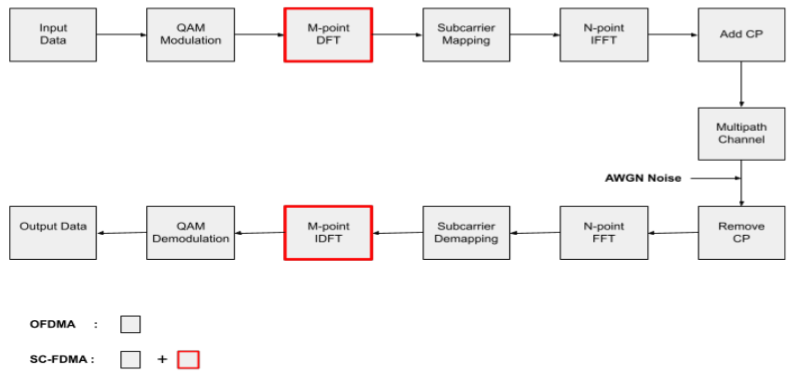Investigations on PAPR and SER Performance Analysis of OFDMA and SCFDMA under Different Channels
Main Article Content
Abstract
Code Division Multiple Access (CDMA) and Orthogonal Frequency Division Multiplexing are two multicarrier regulatory systems that have improved due to the growing demand in quick communication (OFDM). A frequency division multiplexing (FDM) plot called orthogonal frequency division multiplexing is utilized as a sophisticated multi carrier regulation approach.
Due to its excellent spectrum efficiency and low data rate, the single carrier multiple access system (SC-FDMA) is a unique radio transmission technique that is now employed in long-term evolution (LTE) technology for uplink. When compared to OFDM, reduced peak-to-average power ratio (PAPR) and error rate technique. PAPR performance has been obtained using Matlab simulation. Techniques using variable numbers of subcarriers include SC-FDMA and OFDMA. Two various subcarrier assignment strategies have been proposed, distributed FDMA Localized FDMA and (DFDMA) (LFDMA). IFDMA, or interleaved FDMA, is a DFDMA special situation when DFT results have been distributed consistently and at the same distance. When comparing the SC-FDMA variants, we discover that Localized has a higher PAPR than interleaved (FDMA) (FDMA). We also talk about the Performance of LFDMA and IFDMA's SER (Symbol Error Rate) and found that localized (FDMA) performs better in the SER than interleaved (IFDMA) method.
Article Details
References
Hindy, Ahmed, Udar Mittal, and Tyler Brown. "CSI Feedback Overhead Reduction for 5G Massive MIMO Systems." In 2020 10th Annual Computing and Communication Workshop and Conference (CCWC), pp. 0116-0120. IEEE, 2020.
Guo, Jing, Nanxi Li, Zheng Jiang, Shengnan Liu, and Peng Chen. "System-level Evaluation on Practical Massive MIMO Deployment Scenarios for 5G." In 2019 IEEE 5th International Conference on Computer and Communications (ICCC), pp. 993-998. IEEE, 2019.
Baeza, Víctor Monzón, and Ana García Armada. "Noncoherent Massive MIMO." Wiley 5G Ref: The Essential 5G Reference Online (2019): 1-28.
Dore, Jean-Baptiste, Robin Gerzaguet, and Dimitri Ktenas. "5G cellular networks with relaxed synchronization: Waveform comparison and new results." In 2016 IEEE 83rd Vehicular Technology Conference (VTC Spring), pp. 1-5. IEEE, 2016.
Kansal, Parnika, and Ashok Kumar Shankhwar. "FBMC vs OFDM waveform contenders for 5G wireless communication system." Wireless Engineering and Technology 8, no. 4 (2017): 59-70.
Gupta, Namrata, Ankush Gupta, Santosh Kumar, Rajeev Mishra, Chhaya Singh, and Anil Kumar Tripathi. "Cross-talk between cognate and noncognate RpoE sigma factors and Zn2+-binding anti-sigma factors regulates photooxidative stress response in Azospirillum brasilense." Antioxidants & redox signaling 20, no. 1 (2014): 42-59.
Khademi, Seyran, and Alle-Jan Van Der Veen. "Constant modulus algorithm for peak-to-average power ratio (PAPR) reduction in MIMO OFDM/A." IEEE Signal Processing Letters 20, no. 5 (2013): 531-534.
Salh, Adeeb, Nor Shahida M. Shah, Lukman Audah, Qazwan Abdullah, Waheb A. Jabbar, and Mahathir Mohamad. "Energy-Efficient Power Allocation and Joint User Association in Multiuser-Downlink Massive MIMO System." IEEE Access 8 (2019): 1314-1326.
Hossain, Tamanna, Md Munjure Mowla, and Md Yeakub Ali. "Energy Efficiency Investigation in Massive MIMO 5G System using Nakagami-m Fading Channel." In 2019 22nd International Conference on Computer and Information Technology (ICCIT), pp. 1-5. IEEE, 2019.
Pedram, Massoud, and Luhao Wang. "Energy Efficiency in 5G Cellular Network Systems." IEEE Design & Test 37, no. 1 (2019): 64-78..
Ohno, Shuichi, Emmanuel Manasseh, and Masayoshi Nakamoto. "Preamble and pilot symbol design for channel estimation in OFDM systems with null subcarriers." EURASIP Journal on Wireless Communications and Networking 2011, no. 1 (2011): 2.
Gangwar, Arun, and Manushree Bhardwaj. "An overview: Peak to average power ratio in OFDM system & its effect." International Journal of Communication and Computer Technologies 1, no. 2 (2012): 22-25.
Ali, Moaaz Elhag, Khaizuran Abdullah, Mohammad Umar Siddiqi, and Ahmad Fadzil Ismail. "Impulsive noise mitigation in Haar DWT based OFDM systems." In 2013 IEEE 11th Malaysia International Conference on Communications (MICC), pp. 321-325. IEEE, 2013.
Gheorghe, Cristina-Gabriela, Radu Dragomir, and Dan Alexandru Stoichescu. "Massive MIMO technology for 5G adaptive networks." In 2019 11th International Conference on Electronics, Computers and Artificial Intelligence (ECAI), pp. 1-4. IEEE, 2019.
Chen, Jung-Chieh. "Application of quantum-inspired evolutionary algorithm to reduce PAPR of an OFDM signal using partial transmit sequences technique." IEEE transactions on Broadcasting 56, no. 1 (2009): 110-113.
Al-Jawhar, Yasir Amer, Khairun Nidzam Ramli, Aida Mustapha, Salama A. Mostafa, Nor Shahida Mohd Shah, and Montadar Abas Taher. "Reducing PAPR with low complexity for 4G and 5G waveform designs." IEEE Access 7 (2019): 97673-97688..
Ben CheikhBattikh, D.; Kelif, J.-M.; Coupechoux, M.; Godlewski, P., “Dynamic system performance of SISO, MISO and MIMO Alamouti schemes,” 34th IEEE Sarnoff Symposium, 2011, vol., no., pp.1-5, 2011.
Ho-Jung An; Hyoung-Kyu Song, “Cooperative Communication in SIMO Systems with Multiuser-OFDM,” IEEE Transactions on Consumer Electronics, vol.53, no.2, pp.339-343, 2007.
JingLv; Blasco-Serrano, R.; Jorswieck, E.A.; Thobaben, R.; Kliks, A., “Optimal beamforming in MISO cognitive channels with degraded message sets,” IEEE Wireless Communications and Networking Conference (WCNC), 2012, vol., no., pp.538-543, 2012.
M. Borgmann and H. Bölcskei, “On the Capacity of Noncoherent Wideband MIMO-OFDM Systems,” IEEE International. Symposium.Info. Theory, Adelaide, Australia, pp. 651–55,Sept 2005.
HiroshiKaiho and Takeshi Hattori, “Reduced Complexity of Spread Spectrum OFDM for PAPR Reduction and Its Basic Performance,” Information and Communication Sciences,pp.1-5,2009.
Tao Jiang; Yiyan Wu, “An Overview: Peak-to-Average Power Ratio Reduction Techniques for OFDM Signals,” IEEE Transactions on Broadcasting, vol.54, no.2, pp.257,268, June 2008.
Shao Lulu, Song Qijun, Zhang Hongshun, Zhang Jiaping, “Research on Application of OFDM Technology in Cooperative Spectrum Sensing,” pp. 254,257, 16-20 Sept 2009.
VanDuc Nguyen; Kuchenbecker, H.-P., “Intercarrier and intersymbol interference analysis of OFDM systems on time-varying channels,” Signal Processing Advances in Wireless Communications, 2003. 4th IEEE Workshop on SPAWC 2003., vol., no., pp.140,144, 15-18 June 2003.
Rodrigues, M. R D; Wassell, I.J., “A novel coding strategy to improve the error probability performance of non-linearly distorted OFDM signals,” Vehicular Technology Conference, 2003. VTC 2003-Fall. 2003 IEEE 58th , vol.1, no., pp.294,298 Vol.1, 6-9 Oct. 2003.
Kaiho, H.; Hattori, T., “Novel Scheme of Oversampling Spread Spectrum Roll-Off OFDM for PAPR Reduction,” Vehicular Technology Conference, 2009. VTC Spring 2009. IEEE 69th , vol., no., pp.1,5, 26-29 April 2009.

